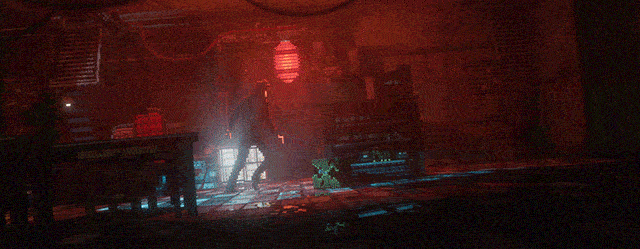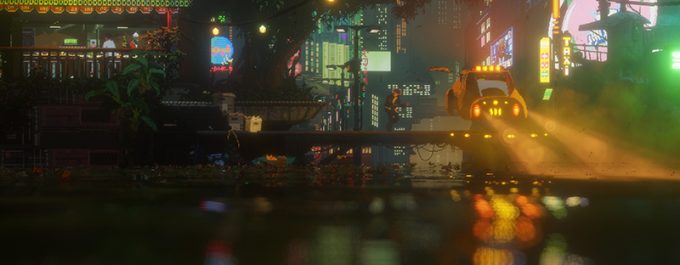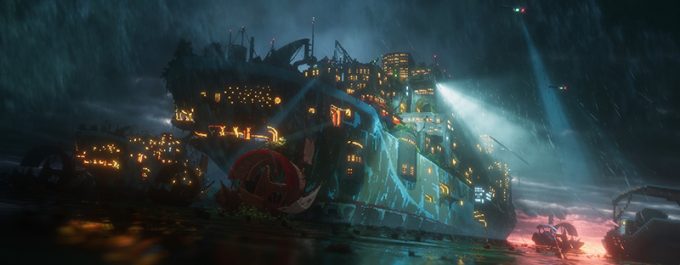“Our demo is broken. All I can show you is the Unity file. Is that okay?”
Honestly, as someone who loves the inside baseball of game development, those words were the music to my ears. What I saw next made my design degree filled heart giggle with joy.
I’ve spent thousands of hours fucking around with Adobe Photoshop’s filters. It became a sort of weird tradition to spend early Friday nights in front of my desktop and the latest dump of fan-created plugins before heading out to the bar to get inebriated with friends. I figured out how to make people glow, hair catch fire, and animals hybridize into stranger, more malevolent forms. I had a blast, and I came up with some weird but interesting shit, although it never went anywhere besides a dank folder on my desktop.
I think Odd Tales’ Tim Soret did the same thing, but with Unity instead of Photoshop.
His latest project, The Last Night, features absolutely stunning art. The game mixes 16-bit era pixels with early New Millennium filter chaos, throws in neon lights and parallax scrolling, and finishes with a sense of life and visual depth that pops everything out at us. Whew. Soret, who has a background in advertising, knows how to make things look good and catch eyes. He also knows that if he can’t get a demo running, he might as well throw open Unity and show us the layers of his work, the magic behind the curtain.
We see how every aspect of the game is made, from the title screen to the street scenes, and how they’re all linked together in the popular dev software. “It’s all very easy,” he brags (and he’s right, it actually is quite easy to learn Unity). By layering the plethora of available effects he’s able to make the world capture a cyberpunk aesthetic reminiscent of Blade Runner. The game could have easily been a traditional 2D adventure game, he tells us, but by tilting the perspective ever so slightly he’s able to add an almost dioramic depth that accentuates the emotive side of the environment. Now, lights shine behind figures, shadows cast onto the floor, and puddles of rain water ripple as NPCs walk through them, reflecting the signage of the buildings back into the night sky.

“The title screen is all done in Unity. I can move the neon lights around anywhere I want. Watch.”
“And this is all in Unity?!” I ask, as if I’ve never seen COMPUTER GRAPHICS before.
“Yes, watch what I do next.”
Soret opens up a scene with the main protagonist atop a vehicle — the big scene from the game’s debut trailer at Microsoft’s Xbox Briefing — and proceeds to adjust the camera angle, the aperture of the lens, and the location of the lighting. Then, he hits “PLAY” on the animation, as if to show off. All of this completely changes the mood of the setting. It goes from something heroic, to something stoic, to something almost with a level of sadness to it.

As he flips back and forth between the tools, my eyes bulge out and my tongue wags in synchronicity. With a background in art and design, I think I’m the only one in that tiny demo room hyperventilating at what we’re seeing. It really does feel like he’s literally throwing every effect at the screen to see what sticks and what looks cool, but there’s a definite method to what he selects.
The Last Night is a conversation about Transhumanism, or how humans are becoming so obsessed with technology that our own lives are controlled by it. Where we once drove a car, the car now drives for us (or will, in just a few short actual years). Where we used to go to a grocery store to buy cabbage, Amazon drops it onto our roof with a drone, usually before we even know we’re about to run out of the delectable leafy vegetable. We do this because, eventually, we’ll end up like the humans in Wall-E. Our only existence now is to consume, earning rewards if we consume enough. The neon lights are meant to entice us, to point us to shops or experiences that further drive us apart. Buy food from here and get five points! Buy a drug today and get 10 points!
The Last Night asks if we’re ready for all of that. It wonders if we really want to give up our individuality for the sake of convenience. Its world is one in which humanity has willingly given up almost every aspect of its self, through our connection to the machines around us.

Everyone, that is, except for the story’s protagonist, who for reasons unknown to him cannot make that connection. The mystery unfolds in a futuristic noir mixed with influences by Eric Chahi’s Another World (Out of This World in the West). There’s light action and complex choice, and as we interact with other characters they remember how we treat them, affecting our choices and situations later on. The game will further make us claustrophobic, throwing in political factors, police states, and AI run amok. Until we’re able to unravel our great mystery, we’re trapped.
It’s a lot like Black Mirror, in a way. It presses our need for specific aspects of technology and how our dependence can drastically alter who we are. At least it does so with an amazing intersection between technology and art, and one that could be as thought-provoking as it is beautiful.
The Last Night is targeting 2018 for release on PC and Xbox One.
The Last Night recently took home a SideQuesting Best of E3 2017 Award


No Comments